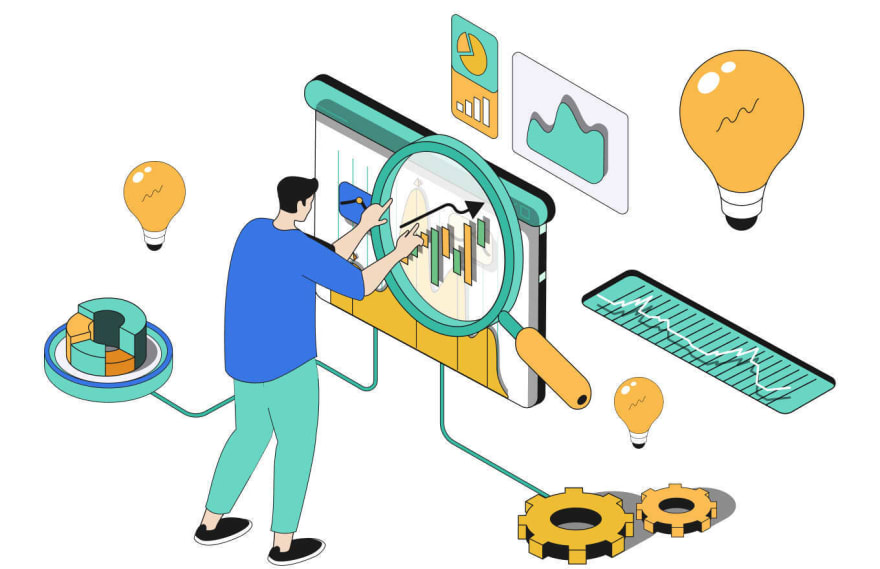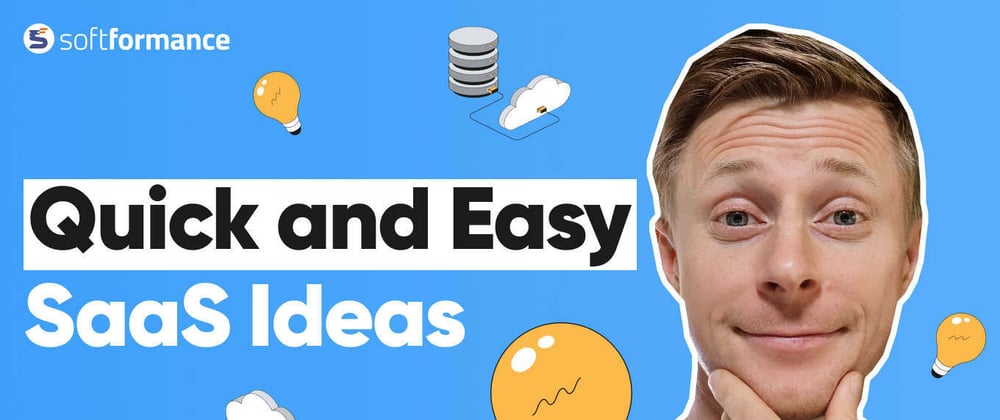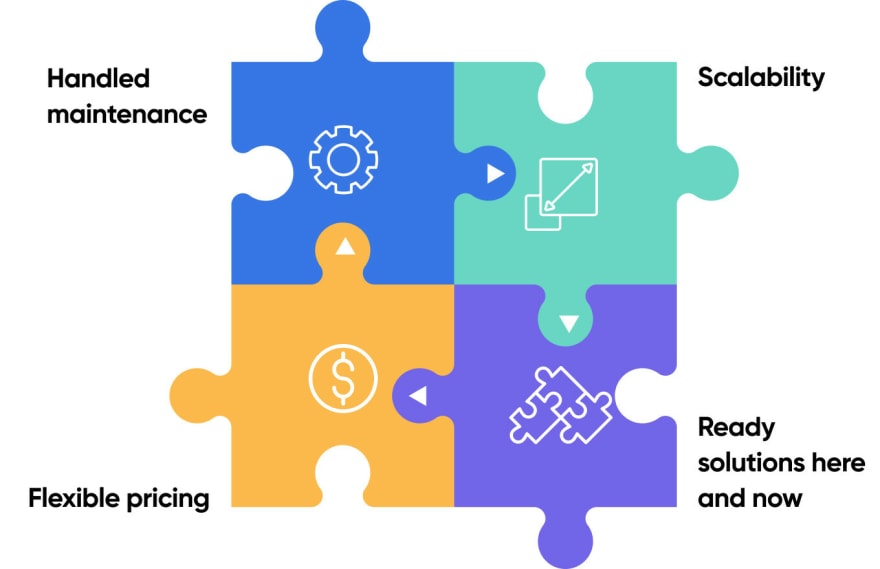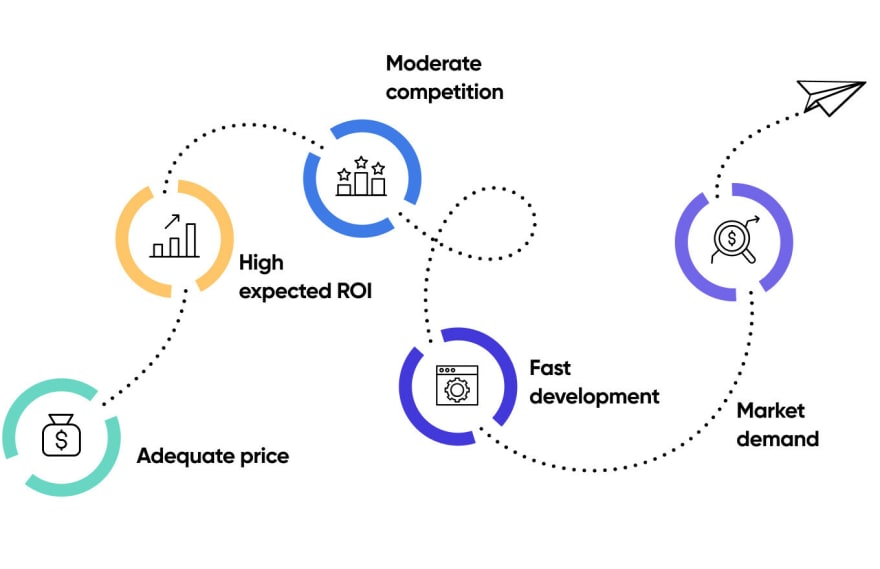The original article was written by SoftFormance https://www.softformance.com/blog/micro-saas-ideas/
Currently, there are around 14 billion SaaS accounts globally.
It is much bigger than our planet’s population. And if you find such a number unrealistic, just think that some people may have up to dozens of accounts on different SaaS platforms.
What is even more impressive is that these numbers keep on growing.
It is expected that the global market for SaaS platforms will grow from USD 130.69 billion in 2021 to USD 716.52 billion in 2028.
What’s really cool is the fact that you shouldn’t necessarily have a great budget to run your own SaaS platform. You can go with either a large and costly SaaS platform or a cost-efficient micro-SaaS project.
In both cases, a really good idea is your key to success.
And if you don’t know where to find one, read this article.
Here you will find the information that will help you understand SaaS benefits much better and come up with stellar ideas for both large SaaS projects and micro-SaaS startups.
SaaS Ideas and How They Can Help You
Let’s start with a traditional clarification of what a SaaS platform is.

Basically, it is a software service (usually, cloud-based) that is accessed by its users online. It is usually offered via a subscription principle.
If you need more information on this term and its meaning, make sure to check out our article on the SaaS business model.
The most important thing about SaaS is that it can bring great profit to software founders. After all, there are already 25.000 companies using SaaS worldwide.
And this means that there’s a solid demand for SaaS products.
What stands behind the popularity of this software model?
We will explore this in the next chapter.
Why Are SaaS Startups so Popular Today?
Basically, there are two aspects of SaaS popularity.
First, they bring solid advantages to software founders running such products.
Secondly, the SaaS model has many features making it popular among users.
SaaS Platform Benefits for Software Founders
If you are a software founder with great SaaS software ideas, expect to receive the following benefits:
- High customer retention. Most customers don’t like switching from a SaaS platform that fulfills their basic needs. Therefore, the overall customer retention rate for SaaS products ranges between 92-97%.
- High lifetime value. This advantage is especially relevant when it comes to B2B SaaS startups. For example, most Ahrefs users are SEO-oriented companies with significant budgets that are ready to spend solid money on the platform that fulfills their needs.
- Great marketing opportunities. With a market that is annually growing by 27.5%, SaaS development remains a hot trend. And each hot and popular software trend means great opportunities for marketing promotion. SaaS Platform Benefits for Customers One more important reason for SaaS popularity is that this software model brings many benefits to ordinary customers. Here are the ones that deserve the most attention:
- Handled maintenance. Customers are very comfortable with SaaS products because fixes, maintenance, and upgrades are usually handled by a software provider.
- Scalability. Typically, SaaS solutions are really big and fully employ the scalability of cloud technologies. That’s why any user can easily scale the platform up by paying an additional fee. This benefit may be especially relevant to the owners of rapidly growing businesses.
- Flexible pricing. Most SaaS platforms, such as Adobe, have different pricing plans. This means that users pay only for resources and features they really use.
- Ready solutions here and now. Most business customers don’t have too much time to develop a software product. Meanwhile, while subscribing to a SaaS platform, they receive a ready solution instantly. What is Micro SaaS? A great thing about SaaS is that you don’t need to be a rich business genius to succeed.
Some SaaS platforms are developed with a very moderate budget. These are typically called micro SaaS apps.
How will I define a micro SaaS platform?
Well, it is a niche market product that is run by one person or a small team. Surely, a micro SaaS is also about a very moderate budget.
What is an example of a micro SaaS platform?
Pramp, a tool for interview practice and voice training would be a perfect example.
This platform is run by a small team and has a very niche-specific functionality that allows it to stay out of the competition.
How Does Micro-SaaS Differ From Traditional SaaS?
Now that you know about micro SaaS, let’s clarify what are the main features distinguishing it from traditional SaaS.
The table below clearly illustrates those differences.
SaaS:
- Cash source - VC Money
- Differentiation - Competitive advantage
- Market - Total market
- Growth model - T2D3 growth
- Investment style - Aggressive
- Team size - 1-up to a dozen of people
Micro SaaS:
- Cash source - Self-funding
- Differentiation - Uniqueness
- Market - Niche
- Growth model - Steady growth
- Investment style - Controlled
- Team size - Dozens or hundreds of members
Way to Validate Startup Ideas
Suppose you have an interesting SaaS startup idea.
How can you be sure that it will, actually, work?
Everything depends on you and your goals/plans/desires/dreams.
However, I can certainly provide you with a list of points to consider while validating SaaS ideas.
These are:
- Adequate price. Choose the price that is adequate according to you and your budget. Just remember that overspending on questionable and risky ideas, usually, makes no sense.
- High expected ROI. One more time, choose ROI measures that are adequate for you. Then, do your best to reach your dream ROI and beyond.
- Moderate competition. To create a product that will thrive in a competition-loaded niche, you should deliver something special. It’s always better to come up with a relatively new idea and enter a market with moderate competition.
- Fast development. If SaaS development takes you too much time, your product may become irrelevant by the time of its release. That’s why we recommend you focus on apps developed within a few month-half a year.
- Market demand. You may develop an excellent app but what’s the point if it doesn’t bring actual value to the audience? Always be sure that your SaaS idea is demanded and helps your target users. 15 Great SaaS Ideas and How to Build Them Now, it’s time for the main thing that has gathered all of us here.
- SMM Management Platform Social media marketing remains one of the most popular business promotion directions in the world.
And the demand for SMM management apps remains high. These are the platforms that help companies automate their SMM practices, enhance competitor research, find the most relevant topics, pick up the most popular hashtags, and analyze SMM strategy efficiency.
Just mind that some features can be challenging to implement, and you may go for AI/ML Python algorithms to establish solid analytics.
Example: HubSpot
Approximate MVP cost: $130,000-$180,000
Approximate MVP development time: up to 5-6 months
Step-by-step approach:
Thoroughly research the market and your target audience to come up with a list of the most demanded features. You can choose a specific marketing niche to narrow down the research.
Start developing a highly-scalable software that can be easily expanded with new services on demand.
Support your app with powerful analytical algorithms. You can create ones with AI/ML technologies.
Release your product MVP to collect user feedback.
Improve your SaaS using this feedback and choose the most suitable subscription model.
- Workforce Communication System Although the market has many workforce communication systems, the demand for such apps remains high.
The point is that new companies and professional teams appear at an ever-increasing pace. And all of them need tools to create chats, enable them to share files, and host online meetings.
Moreover, many teams have very specific demands and may switch from the most popular industry picks to the newcomers who provide more attractive pricing or customizable experience.
This means that you can thrive with a workforce communication SaaS platform despite the competition.
Example: Slack
Approximate MVP cost: $90.000-150.000
Approximate MVP development time: 3-5 months
Step-by-step approach:
Research the market and identify user needs.
Ideally, come up with a unique or rare feature that will be your platform’s selling point (for example, the ability to merge different chats upon demand).
Develop your platform and pay much attention to its security and flexibility.
Validate the app and its design to provide the best customer experience.
Release the MVP and collect user feedback for, at least, one month to see how you can improve it.
- CRM System for Freelancers Freelance is on the rise, as more and more companies rely on the network of remote workers.
Some freelancers may have dozens of active projects at once.
So, a CRM system that will help them keep everything under control would be more than relevant.
There’s some competition in this niche, but it mostly lacks indisputable leaders.
That’s why such a platform is listed among the best SaaS ideas.
Example: Zoho
Approximate MVP cost: $100.000-160.000
Approximate MVP development time: 3-4 months
Step-by-step approach:
Identify user demands and research the products that your competitors offer.
Come up with a list of features. It may include interactive calendars, scheduling options, communication channels, task dashboards, file repositories, and so on.
Develop the platform with the best CRM development technologies.
Validate the MVP and release it to collect user feedback.
Use the feedback to expand the platform’s functionality.
- Personal Finance Management Platform With the growing popularity of financial literacy, there appears a great demand for personal finance management apps.
If you need a tool that will help you track your spending, set budget limits, schedule payments, and build budget plans, such apps are your panacea.
Following such SaaS product ideas is not an easy task because the app should be secure and perfectly integrate with payment systems. However, the promises are really high, and you may read my recent article onbuilding a personal finance app for more detail.
Example: Mint
Approximate MVP cost: $80.000
Approximate MVP development time: 2-3 months
Step-by-step approach:
Come up with the best product strategy and roadmap for its development. Research the market and choose a feature set that proves to be the most demanded.
Create a user-friendly UI/UX design.
Develop an MVP and integrate it with popular payment systems.
Ensure top-quality security of your personal finance management app.
Release the MVP and collect user feedback to enhance further product development.
- Interface Design SaaS The app and website development market is growing at an annual growth rate of 23%.
This means that new web apps appear constantly, and each needs a unique design and interface.
Give web developers and designers what they need with a tool that will allow them to create custom designs, share them with other designers, and collaboratively improve these interfaces.
Example: Figma
Approximate MVP cost: $140.000-190.000
Approximate MVP development time: 5-6 months
Step-by-step approach:
Research the market and choose the most relevant feature set and workforce model.
Create a user-friendly UI/UX design.
Develop an MVP and enhance it with various web design development plugins.
Release the MVP and develop the platform according to the user feedback.
Choose the most relevant pricing model for your product.
- Service Management and Customer Relationships Platform Many small businesses and regular specialists have challenges with managing their services and customers.
That’s why building a SaaS platform that helps them manage their services, communicate with buyers, and provide customers with paid or free consultations is a good idea.
Just make sure to choose the right niche for your product. In this case, you may even avoid the competition.
At least, that is how ForwardForms, an excellent customer management SaaS for stylists and beauty studios, has been built.
Example: ForwardForms
Approximate MVP cost: $60.000-130.000
Approximate MVP development time: 2-3 months
Step-by-step approach:
Research the market and find the niche that perfectly fits your idea.
Come up with a set of features that would be relevant to entrepreneurs working in this niche.
Develop an MVP that provides the customer with the basic functionality.
Release the MVP, collect user feedback, and use it to develop your platform.
Choose the best subscription model for your service.
- Commercial Intelligence Platform Financial analysis and complex estimations take digitized businesses too much time and effort.
That’s why quality analytical apps that help them automate these processes are always in great demand.
Just make sure that your app securely stores all financial data and corresponds to the needs of a specific industry.
Example: Revenue Compass
Approximate MVP cost: $60.000-90.000
Approximate MVP development time: 2-4 months
Step-by-step approach:
Choose the niche that your product will focus on and decide on the scope of features to include in it.
Create user-friendly mechanics and a solid UI/UX design.
Develop your platform and integrate it with excellent analytical features. You may also use AI/ML algorithms for more efficient analytics.
Release the MVP version of your product to see how it helps specific businesses that agree to use its trial version.
Improve your product, expand its functionality, and decide on the subscription model.
- Feedback Management Platform Whether companies need to measure the experience and progress of their employees or to know the satisfaction rates of their customers, a feedback management platform is a solution.
It is a SaaS product that processes employee reviews or customer feedback surveys and provides dynamic reports.
Such an app should also include interactive dashboards and interactive storage for feedback records.
Example: Feedier
Approximate MVP cost: $50.000-80.000
Approximate MVP development time: 2-3 months
Step-by-step approach:
Research the market, decide on the functionality of your solution, and create a detailed project roadmap.
Build a solid UI/UX design that will fit your target audience.
Develop the app and pay special focus to interactive reporting features.
Release the MVP and collect user feedback.
Establish your platform, improve it, choose a subscription model, and focus on its market promotion.
- Data Storage SaaS As long as data rules the Internet, data storage SaaS platforms will always remain relevant.
Even with the great competition, non-flexible pricing plans make companies and ordinary users seek more cost-efficient and customizable data storage solutions.
That’s when you can take advantage. The key point is to deliver a truly secure and scalable platform with an attractive pricing plan.
Example: Dropbox
Approximate MVP cost: $120.000-190.000
Approximate MVP development time: 4-5 months
Step-by-step approach:
Research the market and decide on the set of features that will help your data storage solution stand out from the competition. More flexible pricing plans, auto-scaling, or expanded data exchange options may go as good variants.
Develop your data storage with a special focus on scalability.
Pay attention to security testing as a separate stage that is extremely vital to your project and its success.
Release your app MVP and collect user feedback.
Improve your platform, add features, and implement a customer-oriented approach in your placing and platform distribution.
- Accounting SaaS Platform Big companies have large departments responsible for accounting.
But when it comes to small businesses with solid cash flows, accounting is typically handled by a limited number of employees.
Or, sometimes, companies don’t have professional accountants at all.
That’s why a solution that automates accounting processes is a hot property among small businesses.
Example: QuickBooks
Approximate MVP cost: $40.000-70.000
Approximate MVP development time: 2-3 months
Step-by-step approach:
Focus on a specific user group, come up with a list of features that you will implement, and develop a detailed project roadmap. Competitor research will also come in handy.
Develop an app with a special focus on strong analytical features and storage capabilities.
Establish data labeling and strong information security safeguards.
Release an MVP and see how specific companies run your product during trials.
Expand your platform, fix the issues, and choose a pricing model that perfectly fits both you and your target customers.
- Sales Automation Platform With the growing awareness of customer journeys, tools that allow businesses to control each stage of this journey become increasingly popular.
That’s why releasing a platform that would create “buyer funnels” would be a great idea.
The basic functionality for such an app is emailing and distribution of links across the Internet, link tracking, user behavior analysis, and customer management.
Surely, there are many more to include in your app. The key point is that a sales automation platform will help you handle your routine sales processes more efficiently and with less effort.
Example: Click Funnels
Approximate MVP cost: $140.000-170.000
Approximate MVP development time: 5-6 months
Step-by-step approach:
Decide on your target audience and come up with a set of features that are especially relevant to your potential customers. And don’t forget about competitor research.
Create a user-friendly and simple UI/UX design for your platform.
Develop your app MVP with basic functionality, such as ad automation and customer conversion analysis features.
Release the MVP to collect early user feedback and see how they apply your platform’s basic functionality.
Use MVP feedback to improve your app according to market demands.
- Construction Design CRM Construction companies that provide specific services to households often have to provide their customers with visual schemes of their services and their outcomes.
And, for sure, a tool that helps them plan the design and visualize it may be very useful to these guys.
If you’re a software founder, a very valid benefit of such software is the opportunity to choose a narrow market niche and take your place in it.
For example, LocalPower, one of the best SoftFormance customers, has successfully implemented a solar panel planning CRM platform.
Example: LocalPower
Approximate MVP cost: $80.000-90.000
Approximate MVP development time: 2-4 months
Step-by-step approach:
Choose the niche you want to occupy and the set of features that will be relevant to this niche.
Develop your MVP with a user-friendly design and rich customer management functionality.
Add technical planning features. You may also integrate your application with tools for design visualization.
Release an MVP and see how your customers use its basic functionality.
Improve your app, implement additional features, and get prepared for continuous upgrade and maintenance tasks.
- Property Management SaaS Real estate is always in demand. Moreover, it usually goes about real money in this sphere.
That’s why creating a property management SaaS platform may be an excellent idea.
And don’t forget to include functionality for both property managers and real estate agents.
If all of them find your platform useful, it may have a very bright future.
Example: DoorLoop
Approximate MVP cost: $60.000-90.000
Approximate MVP development time: 1-3 months
Step-by-step approach:
Decide on the features you will include in your property management tool. Also, research the competitors to understand their selling points and deliver a better product.
Create different UI/UX designs for different platform user groups.
Develop the application. If needed, integrate it with third-party tools for financial planning, analysis, and market research.
Release an MVP and deliver it to the representatives of your target user categories.
Optimize your platform, add new features, and choose a pricing model that fits you the most.
- Email Automation SaaS A typical mid-size business spends $10-$1500 per month on email marketing.
To be closer to the “$10” party, a business executive should save the time and effort required for email newsletters and related marketing practices.
And email automation platforms are here to help such businesses.
Not only do they automate most email marketing processes but also increase the percentage of letters that avoid the “spam” folder.
So, quality automation software is a great opportunity to bring real value to businesses that want to run their email marketing campaigns as successfully as possible.
Example: Mailchimp
Approximate MVP cost: $80.000-145.000
Approximate MVP development time: 3-4 months
Step-by-step approach:
Research the market and try to outclass your competitors’ main selling points.
Develop user stories to come up with an excellent UI/UX design for your platform.
Integrate your app with the world’s best mailing platforms. If needed, support it with analytical tools that will research the efficiency of email campaigns.
Find a limited group of businesses that will test your MVP in practice for free.
Optimize your platform, choose the best pricing model, and go on with its continuous support and development.
- Document Management Platform People don’t like messing with documents. I, personally, hate it, especially if there are too many such documents.
And using document management platforms is the best solution to all these troubles.
Deliver a SaaS app that will enable users to share, store, distribute, and sign documents, and you will get your audience.
Example: DocuSign
Approximate MVP cost: $80.000-130.000
Approximate MVP development time: 3-4 months
Step-by-step approach:
Decide on the functionality you include in your document management platform.
Build user-friendly UI/UX design that accepts different roles (document creator, document receiver, etc.).
Develop a SaaS platform MVP.
Ensure the best security practices and integrate your platform with the best security monitoring tools to prevent data leaks.
Release your MVP, collect user feedback, and improve your document management SaaS according to this feedback.
Conclusions
With all its tangible benefits, SaaS development remains a hot trend in the software industry.
Just consider that even a micro SaaS that costs you $60.000 can bring you more than $10.000 monthly.
BUT!
It won’t go without a good SaaS startup idea.
Luckily, you already have, at least, 15 of them.
And you may check out my recent YouTube video where I share more tips on how to create and validate great SaaS startup ideas.
The only thing left is to find a great partner that would implement these SaaS startup ideas.
SoftFormance, a company with more than 200 successful software projects and a strong focus on SaaS development, is ready to become one.
Contact me and see how we can handle your most ambitious plans in style.
And remember, people need your software!
FAQ
How to find a good idea for micro SaaS?
Market research is your key to success, but you can always find the right direction if you check out the ideas from this article or watch this video.
Are micro SaaS startups really profitable?
Yes, with the right idea and quality development even a SaaS startup that costs you $60.000 will bring you more than $10.000 per month.
Is it true that implementing SaaS ideas can really increase project efficiency?
It is one of the greatest SaaS selling points for your potential customers. They don’t need to wait for a solution or invest in its development. Instead, they receive a ready solution that starts automating their processes and improves their efficiency from the start.
Where can I find competent experts to implement SaaS ideas in my product?
You have already found ones. SoftFormance is a SaaS development company with more than 10 years of expertise and more than 200 successfully completed projects. We know everything about SaaS development and are ready to share our knowledge and expertise with you.











Oldest comments (1)
thank you for sharing the ideas! These ideas not looks the small these are very large ideas from my perspeictive but you have shared the best one and with proper examples.
I wish to see your post about mini ideas b/t the $20,000-$30,000.